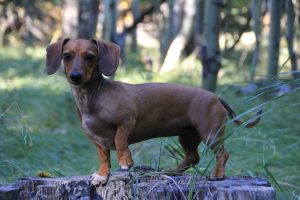Dachshund Fun Facts: The Wiener Dog’s Unique Features

Origin and History of the Dachshund Breed
The Dachshund breed has a fascinating origin and history that dates back centuries. These distinctive dogs originated in Germany and were initially bred for hunting purposes. The word “Dachshund” translates to “badger dog” in German, which perfectly describes their original purpose. Dachshunds were specifically bred to track, hunt, and flush out burrow-dwelling animals such as badgers and rabbits. Their elongated bodies, short legs, and keen sense of smell made them highly adept at navigating underground tunnels and tight spaces in search of their prey.
The exact origins of the Dachshund breed are a subject of debate among historians and dog enthusiasts. Some believe that these dogs have ancient roots tracing back to ancient Egypt, while others argue that they have more recent ancestors from breeds such as the Basset Hound and the German Pinscher. Regardless of their precise lineage, Dachshunds quickly gained popularity in Germany during the 17th century and became renowned for their hunting abilities. Over time, different sizes and coat types emerged, with the breed eventually being recognized in multiple varieties including the long-haired, wire-haired, and smooth-coated Dachshunds.
Physical Appearance and Body Structure of Dachshunds
Dachshunds are known for their unique physical appearance and body structure. They have a long and low body shape, which is their most distinct feature. This breed typically has short legs, a deep chest, and a slightly elongated head. Their bodies are muscular and well-built, allowing them to be agile and quick on their feet. Dachshunds also have a slightly curved tail that adds to their overall balance and agility.
The size of Dachshunds can vary depending on the type and variety. They come in three main sizes: standard, miniature, and toy. Standard Dachshunds typically weigh between 16 and 32 pounds, while miniature Dachshunds range from 11 to 16 pounds. Toy Dachshunds are the smallest of the breed, weighing less than 11 pounds. Regardless of size, Dachshunds have a proud and alert posture, showcasing their confident and independent nature. Their physical appearance and body structure make them easily recognizable and well-suited for their hunting and burrowing abilities.
Types and Varieties of Dachshunds
Variety is the spice of life, and it certainly holds true for Dachshunds. This beloved breed comes in various types and sizes, each with its own unique features. The three most common types of Dachshunds are the standard, miniature, and toy. The standard Dachshund is the original version, standing about 8 to 9 inches tall at the shoulder and weighing around 16 to 32 pounds. On the other hand, the miniature Dachshund is a smaller version, measuring around 5 to 7 inches tall and weighing approximately 9 to 12 pounds. Lastly, the toy Dachshund is the tiniest of them all, standing at about 4 to 5 inches tall and weighing just 8 pounds or less.
Aside from the different types, Dachshunds also come in a variety of coat colors and patterns. Common coat colors include red, black, chocolate, tan, and cream, while patterns can range from solid to dappled, brindle, or even piebald. These beautiful variations contribute to the charm and attraction of Dachshunds, allowing potential owners to find a dog that matches their preferences. Whether you fancy a standard red Dachshund or a miniature dappled one, there is a type and variety of Dachshund to suit every dog lover’s taste.
Dachshunds’ Distinctive Long and Low Body Shape
The distinctive long and low body shape of Dachshunds is one of the most recognizable characteristics of the breed. With their elongated bodies and short legs, Dachshunds possess a unique physique that sets them apart from other dog breeds. This distinct body structure is the result of selective breeding, as Dachshunds were specifically bred for their ability to hunt burrowing animals. The elongated body allowed them to enter tight spaces and the short legs enabled them to dig and maneuver underground.
The long body of Dachshunds is supported by a strong and flexible spinal column, which enables them to stretch and bend as they navigate different terrains. Their deep chests and well-developed forelimbs provide the necessary strength and agility for their hunting and digging abilities. Additionally, Dachshunds’ front legs are set relatively far apart, which helps them maintain stability and balance while moving at fast speeds. This unique body shape not only contributes to their hunting prowess but also adds to their charm and endearing appearance.
Unique Traits and Temperament of Dachshunds
Dachshunds possess a number of unique traits that set them apart from other dog breeds. One of the most remarkable characteristics of Dachshunds is their fearless and bold nature. Despite their small size, Dachshunds have an innate sense of confidence and will not back down from a challenge. This makes them excellent watchdogs, as they will fiercely protect their families and territory.
In addition to their bravery, Dachshunds are known for their lively and playful temperament. They have a natural sense of curiosity and love to explore their surroundings. Dachshunds are often described as being energetic and enthusiastic, always ready for an adventure. Their playful nature makes them great companions for children, as they are always up for a game of fetch or a fun-filled day at the park.
Dachshunds’ Exceptional Hunting Abilities
Dachshunds are renowned for their exceptional hunting abilities. This breed was originally bred in Germany for the purpose of hunting badgers, and their name even translates to “badger dog” in German. With their distinctive long and low body shape, Dachshunds were specifically designed to pursue and dig into the burrows of these small prey animals.
One of the key traits that contributes to their success as hunters is their remarkable sense of smell. Dachshunds have an incredibly keen nose, which allows them to track scents over long distances. This makes them highly proficient at locating not only badgers, but also other small game such as rabbits and squirrels. Their strong scenting ability paired with their persistence makes them excellent at flushing out prey from their hiding places. Additionally, their short legs and compact body provide them with the agility and maneuverability needed to navigate through dense underbrush and tight spaces, making them incredibly effective hunter
Health Considerations for Dachshund Owners
One important aspect of owning a Dachshund is being aware of their unique health considerations. Due to their long and low bodies, Dachshunds are prone to certain orthopedic issues, particularly in their spines. This is why it is crucial to handle them with care, avoiding any rough activities or undue strain on their backs. Regular exercise is important for their overall health and weight management, but it should be done in a controlled manner to avoid exacerbating any potential spinal issues.
In addition to spinal health, Dachshunds are also prone to weight gain, which can put additional pressure on their already vulnerable backs. As such, maintaining a balanced diet and monitoring their food intake is essential. Obesity not only increases the risk of orthopedic problems but can also lead to other health issues, such as diabetes or heart disease. Regular visits to the veterinarian for check-ups and vaccinations are also crucial to ensure that any potential health concerns are caught early and addressed effectively. By being proactive and attentive to their unique health needs, Dachshund owners can provide the best possible care for their beloved pets.
Dachshunds’ Adaptability to Various Living Environments
Dachshunds are known for their adaptability to various living environments. Whether you live in a spacious house with a backyard or a small apartment in the city, these clever dogs can easily adjust. Their small size makes them well-suited for apartment living, as they can thrive in limited space. They are also content indoors and will happily curl up on the couch or relax in their favorite spot. However, it is important to note that Dachshunds still require regular exercise to maintain their physical and mental well-being. Taking them for daily walks and providing them with interactive toys can help keep them happy and healthy.
Additionally, Dachshunds can adapt to different climates and weather conditions. Their short coats make them comfortable in warm weather, and they tend to enjoy basking in the sunshine. However, as they have a low body-to-leg ratio, they can also easily feel the cold, so it’s important to protect them during chilly temperatures with appropriate clothing or blankets. Overall, Dachshunds’ adaptability to various living environments makes them a great choice for individuals or families seeking a versatile companion that can thrive and adjust to different settings.
Dachshunds as Family Pets and Their Interaction with Children
Dachshunds make excellent family pets due to their affectionate and loyal nature. They have a strong bond with their owners and love to be included in all family activities. Dachshunds are known to be gentle and patient with children, making them ideal companions for families with young kids. Their small size and playful personality make them a popular choice for families looking for a dog that can interact and engage with children.
One important aspect to consider when bringing a Dachshund into a family setting is the need for supervision during playtime. While Dachshunds are generally good-natured, their long backs are susceptible to injury. It’s important to teach children to handle Dachshunds gently and avoid rough play, which could potentially harm the dog. By setting clear boundaries and teaching children how to interact with their Dachshund safely, families can ensure a harmonious and enjoyable relationship between their pet and children.
Tips for Caring for Dachshunds and Maintaining Their Well-being
When it comes to caring for Dachshunds and ensuring their overall well-being, there are several important factors to consider. First and foremost, providing a balanced and nutritious diet is crucial to their health. Dachshunds have a tendency to gain weight easily, so it is important to monitor their food intake and avoid overfeeding. Consulting with a veterinarian to determine the appropriate portion sizes and types of food for your Dachshund is highly recommended.
Regular exercise is another vital aspect of caring for Dachshunds. Despite their small size, Dachshunds are active dogs and require daily exercise to maintain their physical and mental well-being. This can include daily walks, playtime, and engaging in interactive activities that stimulate their hunting instincts. Additionally, providing them with various toys and puzzles can help keep them mentally stimulated.
Maintaining good dental hygiene is also essential for Dachshunds. Like many small breeds, Dachshunds are prone to dental issues such as tartar build-up and gum disease. Regular brushing of their teeth and scheduling professional dental cleanings as recommended by your veterinarian can help prevent these dental problems.
Lastly, providing a safe and comfortable living environment for your Dachshund is crucial. Ensuring that their living space is free from hazards and providing them with a cozy bed or crate allows them to have a designated space to retreat and feel secure.
By following these tips, you can ensure that your Dachshund remains healthy, happy, and well-cared for.






